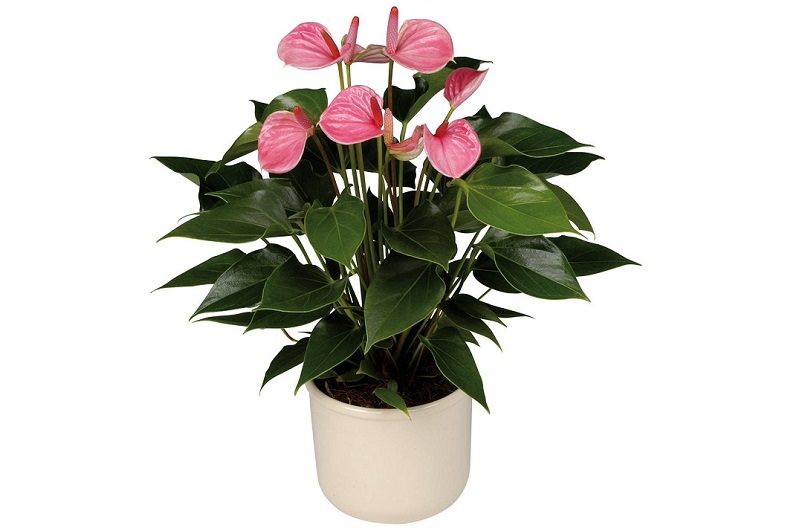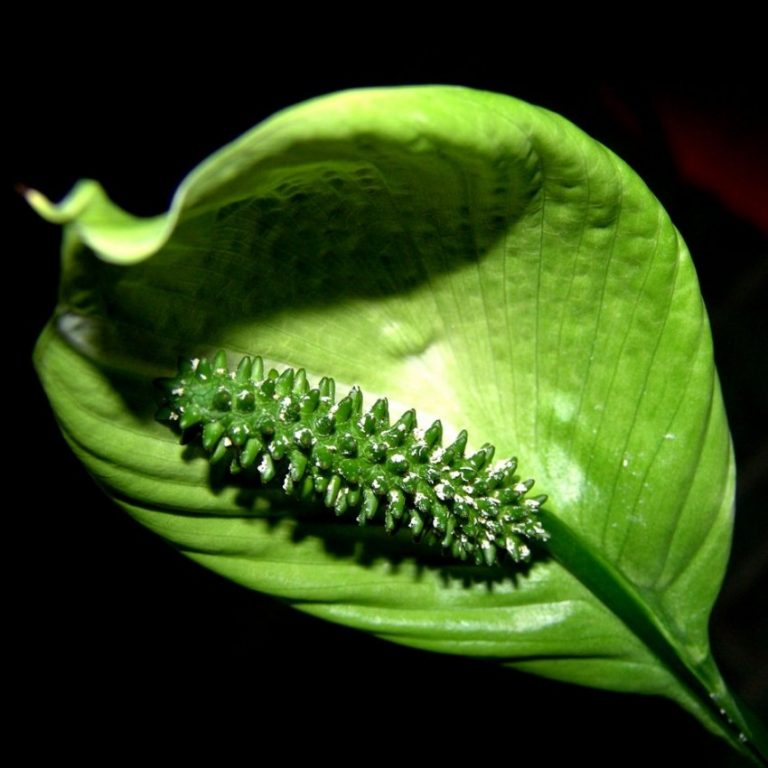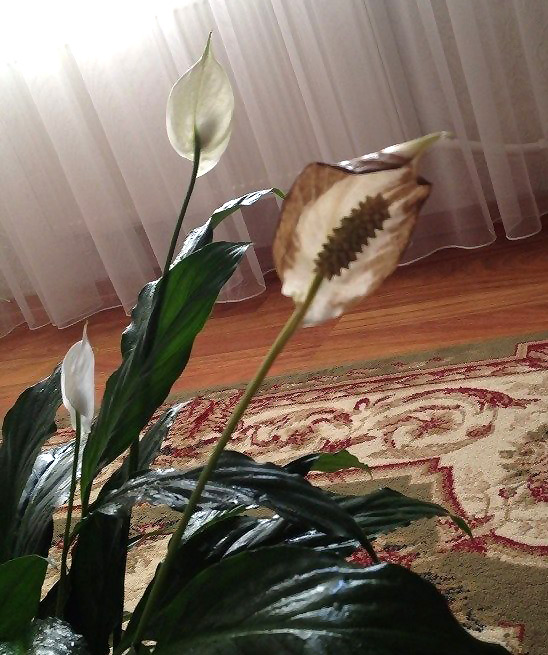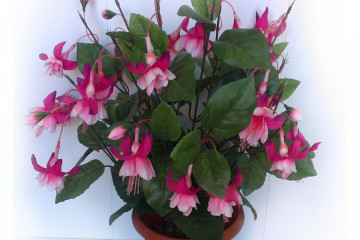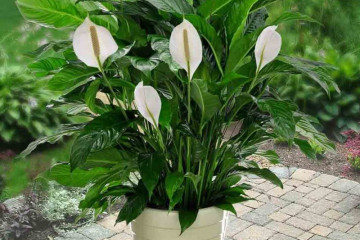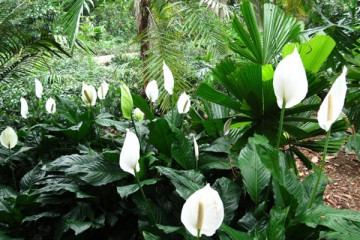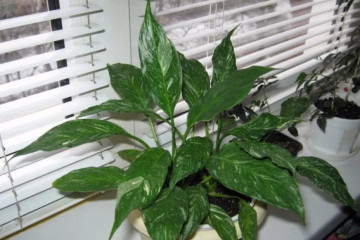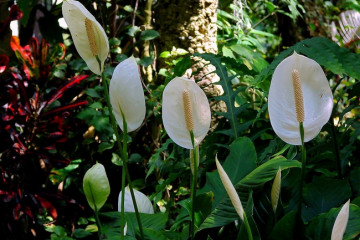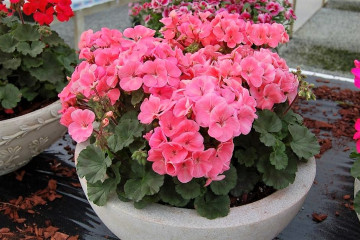Why spathiphyllum does not bloom at home
Content:
Spathiphyllum is a well-known perennial herb that is often grown as a house flower.
What does it look like
Spathiphyllum belongs to the Aroid family. It is a perennial herb native to Colombia, Polynesia and Southeast Asia. The foliage of spathiphyllum is elongated (grows up to 15 cm), oblong or lanceolate. The leaf is dark green, glossy. The flower has practically no stems - the leaves grow almost from the base from the ground on long petioles.
From the Greek language, the name of the plant means "a flower with a veil." It really looks like its inflorescence-ear is framed by a blanket of cream, green or white.
When and how it blooms
The main reason most growers love spathiphyllum is not that the plant requires minimal maintenance, but that it has a long flowering period.
Flower shapes
Spathiphyllum flowers have a very original shape and are the main reproductive organs of the plant. Depending on the specific variety taken, the flowers may vary in size, but their shape is almost identical. The inflorescence is a cob wrapped in a blanket. The latter is often mistakenly considered a single petal.
Main types
Despite the fact that the species includes more than 50 varieties of spathiphyllum, only a few varieties of flowers are grown in indoor conditions, for the rest the house is an uncomfortable place in which the plant simply does not take root.
Spathiphyllum profusely flowering
Abundant flowering spathiphyllum is one of the largest indoor plants of the described species. It can grow up to 60 cm in height. The length of the flower cover is 12 cm, as is the length that the leaf of the plant has.
Wallis Spathiphyllum
This variety can most often be found on the windowsills of apartments. In order for a plant to grow successfully, a minimum of space and maintenance is required. Wallis' spathiphyllum grows up to a height of no more than 40 cm and has a smaller leaf and flower compared to other varieties.
It was these types of flower that became the mother for a huge number of varieties, for example, Picasso, Domino and many others.
Possible flowering problems
Speaking about spathiphyllum care at home, the problems of why the plant does not bloom, why the flowers at spathiphyllum sometimes turn green or begin to turn black, should be given special attention.
Flowering is a natural stage in the life of any plant, if for some reason the spatsiphyllum does not bloom, the first thing to do is to find out the cause of the problem and fix it.
The problems associated with flowering most often turn out to be the following:
- the plant sheds buds;
- releases only leaves;
- the flowers grow green.
Why does spathiphyllum shed buds
Often, flower growers are faced with the following problem: the spathiphyllum peduncle forms a bud, but then it dries up and falls off, not having time to bloom.
The reasons why spathiphyllum does not bloom, in this case, are as follows:
- direct sunlight;
- contact with water buds;
- lack of watering.
For any plant to start blooming, it needs to create optimal conditions. Spathiphyllum does not tolerate direct sunlight. The frequent process of dropping the flowers of the buds with a high degree of probability indicates that the plant has received burns.
The ingress of water on the formed buds is another frequent reason for the plant to drop future flowers. Watering spathiphyllum is recommended from a pallet. In addition, you need to go to a little trick and make good drainage at the bottom of the pot. Each bad bud must be cut off without fail, otherwise the plant will not form and release fresh buds.
Watering the plant should also be given close attention. Without regular watering, not only the buds wither, but the leaves begin to dry out.
Why does spathiphyllum only release green leaves
Many growers complain that spathiphyllum does not bloom and think what to do in such a situation. The plant may stop blooming due to improper care of it. Typically, the following factors cause the problem.
Temperature violation
Failure to comply with the temperature regime, especially in winter, is a frequent factor leading to a lack of flowering. Usually, this takes place if, in the cold season, the spathiphyllum is kept in close proximity to a radiator or any other heating device. In this case, most often it is enough to move the pot to a cooler place, and it will begin to bloom and fade as expected.
Incorrectly chosen pot
An improperly selected planting container is another reason for the lack of flowers. Spathiphyllum, in order to bloom and bloom safely, needs to take all the place in the vessel. Until this happens, there can be no question of any flowers. A simple way to solve the problem is to transplant into a tighter container.
Moisture deficiency
For budding culture, a certain level of moisture is vital. If this indicator does not reach the required level, no feeding can make the plant bloom.
Draft
There are few indoor flowers that tolerate drafts well. In this regard, the plant is strongly recommended to find a suitable place where it will be reliably protected.
Improper feeding
Another significant factor preventing bud formation is too abundant feeding of the plant. Excess fertilizer leads to poisoning. The root system may also be affected.
Why do flowers grow green
Many are interested in the question of why green flowers can appear in spathiphyllum. It is quite logical that such a change in color causes anxiety among flower growers. But the symptom is not always really frightening.
Natural causes of greening
Sometimes the greening of a flower turns out to be related to the age of the plant. The older the plant, the less chance it has of being pollinated. Accordingly, he no longer needs to attract the attention of insects, and his bed-bed-blanket may well turn green.
Greening due to improper care
The answer to the question of why the flowers in spathiphyllum turn green often turns out to be associated with the incorrect care of the plant. Most often, we are talking about the following factors:
- lack or excess of feeding;
- excessive watering;
- the presence of a fungal disease;
- excessive illumination.
How to make spathiphyllum bloom
If you bring together all the recommendations, in order for the spathiphyllum to bloom, you will need to follow simple rules for caring for it:
- reduce the amount of watering;
- place the flower in a cool place;
- from time to time dry the soil in a container and loosen it;
- timely remove dried leaves and wilted buds.
Strict adherence to the listed recommendations will significantly increase the chance of a plant forming flowers.
What to do after flowering
After the spathiphyllum has faded, you will need to carefully remove each flower. As a rule, they are easily removed by hand without the use of tools. Then you will need to cut the flower itself, and the lower the better. During the winter period, the spathiphyllum rests. At this time, he does not need any feeding or frequent watering.
Often it is after flowering that the plant is transplanted. This is done every few years as it grows. A transplant is required when the pot is too small for an overgrown root system. The pot is usually chosen a couple of centimeters larger in diameter - this is enough so that with the onset of spring the ornamental shrub will completely take root and begin to delight with its beautiful original flowers as quickly as possible.
Spathiphyllum is a very common indoor culture, the choice in favor of which can be made even by not the most experienced growers. Despite all the peculiarities associated with flowering, the plant does not require particularly difficult care and feels great in apartments on the windowsills.

